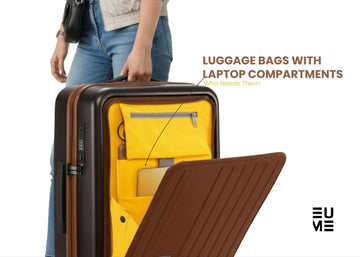Traveling can be stressful, but securing your luggage shouldn't be. TSA locks are a crucial tool for keeping your belongings safe while complying with airport security regulations. In this comprehensive guide, we'll explore the ins and outs of TSA locks, focusing on how to change their codes and why they're essential for modern travel.
What TSA Lock Means?
TSA lock means a security device approved by the Transportation Security Administration for use on luggage. These locks feature a distinctive red diamond logo, making them easily identifiable to both travelers and security personnel. The key feature of TSA locks is that they allow TSA agents to open and inspect luggage without damaging the lock or the bag itself.
Types of TSA Locks
There are two main types of TSA locks:
- TSA Lock with Key: These locks use a traditional key mechanism for locking and unlocking.
- TSA Combination Lock: These locks use a combination of numbers for security.
Both types are designed to be opened by TSA agents using a master key, ensuring smooth security checks during air travel. You can find TSA locks as integrated locks built into luggage or as external TSA locks that can be attached to any bag.
The Importance of TSA Locks
Using TSA-approved locks offers several benefits:
- Enhanced Security: TSA locks provide an additional layer of protection for your belongings during travel.
- Convenience: They allow for hassle-free security checks without the need to cut off traditional locks.
- Damage Prevention: By using TSA locks, you avoid potential damage to your luggage during inspections.
- Peace of Mind: Knowing your belongings are secure yet accessible to authorized personnel can reduce travel-related stress.
How to Set New Code on TSA Lock?
Changing the code on your TSA lock is a straightforward process. Here's a step-by-step guide on how to set new code on TSA lock:
- Set the Current Code: Start by setting the lock to its current combination. If it's a new lock, the default is usually 0-0-0 if the luggage is brand new.
- Locate the Reset Button: Find the small reset button on your lock. You may need a paperclip or safety pin to press it.
- Step 2: Press the Reset Button on Your TSA Lock: Use your tool to press and hold the reset button until you hear the lock release.
- Set Your New Code: While holding the reset button, turn the TSA knob or dials to your desired new combination.
- Release the Reset Button: Once you've set your new code, release the reset button. This action should lock in your new combination.
- Test Your New Code: Before using the lock on your luggage, test it to ensure the new code works correctly. Turn the TSA knob or dials to your new combination and check if the lock opens.
Remember, you can only change the code if you know the current combination. If you've forgotten your code, you may need to contact the lock manufacturer for assistance.
TSA Locks and International Travel
While TSA locks are primarily associated with U.S. travel, they're recognized and accepted in many countries worldwide. Some countries use a similar system called Travel Sentry, which is compatible with TSA locks. However, it's always wise to check the specific regulations of your destination country before traveling.
Choosing the Right TSA Lock
When selecting a TSA lock, consider the following factors:
- Durability: Look for locks made from sturdy materials that can withstand the rigors of travel.
- Ease of Use: Choose a lock with a mechanism you're comfortable operating.
- Visibility: Opt for locks with clear, easy-to-read dials or key mechanisms.
- Brand Reputation: Stick to reputable brands known for quality and reliability.
- Lock Model: Rest assured that regardless of the TSA lock model, rest easy knowing it's designed for security and convenience.
Maintaining Your TSA Lock
To ensure your TSA lock continues to function properly:
- Keep It Clean: Regularly clean your lock to prevent dirt and debris from interfering with its mechanism.
- Avoid Exposure to Extreme Temperatures: Excessive heat or cold can damage the lock's internal components.
- Lubricate When Necessary: If the lock becomes stiff, a small amount of graphite powder can help.
- Store Properly: When not in use, store your lock in a dry, room-temperature environment.
Types of TSA Locks
TSA locks come in various forms to suit different needs:
- Integrated Lock: These are built directly into the luggage, offering a seamless security solution.
- External TSA Lock: These can be attached to any bag, providing flexibility for use on different luggage pieces.
- Combination Lock: These use a series of numbers to secure the lock.
- Key Lock: These use a traditional key mechanism for locking and unlocking.
Setting the Combination on Different Lock Types
The process of setting the combination may vary slightly depending on your lock type:
- For Integrated Locks: Look for a small reset button or lever near the lock mechanism.
- For External Locks: The reset button is typically located on the bottom or side of the lock.
- For Locks with a Padlock Window: You may need to align the new code in the window before pressing the reset button.
Regardless of the lock model, rest assured that the general process remains similar across most TSA-accepted locks.
Looking for reliable and stylish luggage for your next trip?
Check out EUME's extensive collection of luggage designed with built-in TSA-approved locks, durable materials, and innovative features to keep your belongings safe and secure during travel.
If you're traveling with more than one piece, consider EUME's Luggage Bag - Set of 2 or Luggage Bag - Set of 3, perfect for organizing your belongings across multiple pieces while ensuring convenience and security.
Travel Security 101: Essential TSA Lock Questions Answered
Q1: Can TSA agents open all TSA-approved locks?
A: Yes, TSA agents have master keys that can open all TSA-approved locks without damaging them.
Q2: What happens if I forget my TSA lock combination?
A: If you forget your combination, you may need to contact the lock manufacturer for assistance or consider replacing the lock.
Q3: Are TSA locks required for all air travel?
A: While not mandatory, TSA locks are highly recommended for air travel to ensure smooth security checks and protect your belongings.
Q4: Can I use a TSA lock on carry-on luggage?
A: Yes, you can use TSA locks on carry-on luggage, but be prepared to open the lock if requested during security screening.
Q5: How often should I change my TSA lock code?
A: It's a good practice to change your TSA lock code before each trip or at least once every few months for added security.
In conclusion, TSA locks are an essential tool for modern travelers, offering a balance of security and convenience. By understanding how to use and maintain these locks, including changing their codes, you can ensure your belongings remain safe throughout your journey. Remember, a little preparation goes a long way in making your travel experience smooth and stress-free.






















